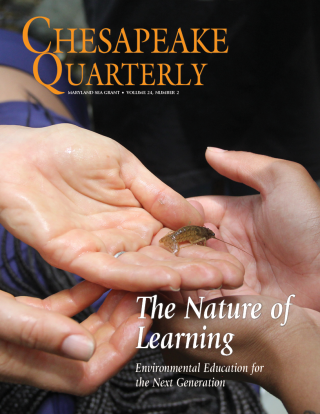Knauss legislative fellowships in Congress help build careers — and they're fun and educational. See our video and fact sheet for details.
R/FISH-108
Development of a Bayesian Approach for Estimating Ecosystem-based Reference Points for Atlantic Menhaden
Principal Investigator:
Genevieve NesslageStart/End Year:
2016 - 2018Institution:
Chesapeake Biological Laboratory, University of Maryland Center for Environmental ScienceCo-Principal Investigator:
Michael J. Wilberg, Chesapeake Biological Laboratory, University of Maryland Center for Environmental ScienceTopic(s):
- Ecosystem-Based Fisheries Management
- Menhaden
Strategic focus area:
Sustainable fisheries and aquacultureDescription:
Atlantic menhaden (Brevoortia tyrannus) play a vital role in Chesapeake Bay and Mid-Atlantic marine ecosystems by providing forage for recreationally important piscivorous fishes while also supporting the largest commercial fishery by volume on the US Atlantic Coast. Recognizing the importance of forage fish such as menhaden to marine ecosystems, fisheries managers have set a goal of adopting ecosystem-based reference points for menhaden that account for the forage services menhaden provide.
However, assessments conducted to date to quantify menhaden forage services have proved too complex and data-intensive to be practical for management use. We propose development of a modeling tool with an intermediate level of complexity for assessing menhaden in an ecosystem context and supporting the development of an Ecosystem-Based Fisheries Management (EBFM) system for menhaden. The specific research objectives of our project are to: 1) Implement a Bayesian surplus production model with time-varying population growth rate to generate associated ecosystem-based reference points; 2) Evaluate model performance with a simulation study; 3) Evaluate the incorporation of predation indices. Our outreach objectives are to: 1) Collaborate with menhaden scientists and managers to ensure maximum impact of research products that address EBFM goals; 2) Engage key stakeholders so they are aware of project progress; 3) Generate a flexible modeling software tool for use by fisheries scientists.
We will develop a Bayesian surplus production model with a time-varying population growth parameter that will generate fishery management reference points that account for ecosystem changes such as predator stock fluctuations. By estimating time-varying intrinsic population growth rate (i.e., growth capacity of the stock), our model will implicitly account for changing predation mortality and will provide fisheries managers with dynamic, MSY-based reference points that account for menhaden’s ecosystem role as forage. Production model performance will be evaluated using an existing simulation model that explicitly links menhaden and predator dynamics. We will then evaluate the performance of our base model relative to alternate versions that explicitly incorporate indices of predator biomass in order to help identify the minimum level of information needed to inform menhaden EBFM efforts. Our project addresses Maryland Sea Grant’s goal of supporting sustainable fisheries as well as ongoing efforts by the State of Maryland and the Atlantic States Marine Fisheries Commission (ASMFC) to pursue EBFM. Additionally, we will produce a flexible software package and associated training materials available online that would allow our approach to be implemented for other forage species.
Related Publications:
Nesslage, GM; Wilberg, MJ. 2019. A performance evaluation of surplus production models with time-varying intrinsic growth in dynamic ecosystems. Canadian Journal of Fisheries and Aquatic Sciences76(12):2245 -2255. doi:10.1139/cjfas-2018-0292. UM-SG-RS-2019-15.



